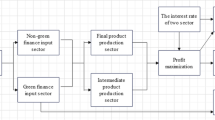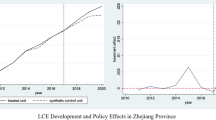Abstract
In the crucial phase of high-quality economic growth, green finance is essential for directing capital to green industries and optimizing the quality of economic growth. Academics in China have paid a great deal of attention to green finance because it is a crucial government policy for advancing the development of an ecological civilization. This document examines the Chinese State Council’s implementation of the Guidance on Building a Green Financial System as a quasi-natural experiment. It determines, using the double difference method and panel data from 283 prefecture-level cities in China between 2011 and 2020, if green financial reform policies can enhance carbon emission efficiency and its mechanisms. The study reveals that green finance reform policies considerably improve the carbon efficiency of cities, albeit with a significant time lag and an annual increase in net effect. In addition, the mechanism analysis revealed that green financial policies primarily improve carbon emission efficiency by decreasing the intensity of energy consumption, enhancing technological innovation, and optimizing industrial structure. Therefore, expanding the size of the reform pilot zone and increasing incentives and guidance for green financial institutions will aid the transition of cities to a low-carbon economy.


Similar content being viewed by others
Data availability
The datasets used and/or analyzed during the current study are available from the corresponding author on reasonable request.
References
Auffhammer M, Sun W, Wu J, Zheng S (2017) The decomposition and dynamics of industrial carbon dioxide emissions for 287 Chinese cities in 1998–2009. Environ Econ Sustain 71–94
Bovenberg AL, Smulders S (1995) Environmental quality and pollution-augmenting technological change in a two-sector endogenous growth model. J Public Econ 57:369–391
Dong Z, Xia C, Fang K, Zhang W (2022) Effect of the carbon emissions trading policy on the co-benefits of carbon emissions reduction and air pollution control. Energy Policy 165:112998
Du K, Yu Y, Li J (2020) Does international trade promote CO2 emission performance? An empirical analysis based on a partially linear functional-coefficient panel data model. Energy Econ 92:104983
Emrouznejad A, Yang GL (2018) A survey and analysis of the first 40 years of scholarly literature in DEA: 1978–2016. Socio Econ Plan Sci 61:4–8
Emrouznejad A, Parker BR, Tavares G (2008) Evaluation of research in efficiency and productivity: a survey and analysis of the first 30 years of scholarly literature in DEA. Socio Econ Plan Sci 42:151–157
Fan H, Peng Y, Wang H, Xu Z (2021) Greening through finance? J Dev Econ 152:102683
Geddes A, Schmidt TS, Steffen B (2018) The multiple roles of state investment banks in low-carbon energy finance: an analysis of Australia, the U.K. and Germany. Energy Policy 115:158–170
Gehrsitz M (2017) The effect of low emission zones on air pollution and infant health. J Environ Econ Manag 83:121–144
Greenstone M (2002) The impacts of environmental regulations on industrial activity: evidence from the 1970 and 1977 clean air act amendments and the census of manufactures. J Polit Econ 110:1175–1219
Greenstone M, Hanna R (2014) Environmental regulations, air and water pollution, and infant mortality in India. Am Econ Rev 104:3038–3072
He L, Liu R, Zhong Z, Wang D, Xia Y (2019) Can green financial development promote renewable energy investment efficiency? A consideration of bank credit. Renew Energy 143:974–984
Heal DG (1974) The optimal depletion of exhaustible resources. Rev Econ Stud 41:3–28
Hong H, Kacperczyk M (2009) The price of sin: the effects of social norms on markets. J Financ Econ 93:15–36
Hou H, Chen M, Zhang M (2022) Study on high energy-consuming industrial agglomeration, green finance, and carbon emission. Environ Sci Pollut Res 1–21
Hu J, Yan S, Han J (2021) Research on implied carbon emission efficiency of China’s industrial sector–an empirical analysis based on three-stage DEA model and non competitive I.O. model. Statistical Research 38:30–43
Jalil A, Feridun M (2011) The impact of growth, energy and financial development on the environment in China: a cointegration analysis. Energy Econ 33:284–291
Jeucken M (2010) Sustainable finance and banking: The financial sector and the future of the planet. Sustainable finance and banking: the financial sector and the future of the planet
Jia R, Shao S, Yang L (2021) High-speed rail and CO2 emissions in urban China: a spatial difference-in-differences approach. Energy Econ 99:105271
Jones AW (2015) Perceived barriers and policy solutions in clean energy infrastructure investment. J Clean Prod 104:297–304
Kahn ME, Li P, Zhao D (2015) Water pollution progress at borders: the role of changes in China’s political promotion incentives. Am Econ J Econ Pol 7(4):223–242
Krogstrup S, Oman W (2019) Macroeconomic and financial policies for climate change mitigation: A review of the literature
Lee CC, Chang YF, Wang EZ (2022) Crossing the rivers by feeling the stones: the effect of China's green credit policy on manufacturing firms’ carbon emission intensity. Energy Econ 116:106413
Lin M, Zeng H, Zeng X, Mohsin M, Raza SM (2023) Assessing green financing with emission reduction and green economic recovery in emerging economies. Environ Sci Pollut Res 30(14):39803
Liu X, Li Y, Chen X, Liu J (2022) Evaluation of low carbon city pilot policy effect on carbon abatement in China: an empirical evidence based on time-varying DID model. Cities 123:103582
Luo S, Yu S, Zhou G (2021) Does green credit improve the core competence of commercial banks? Based on quasi-natural experiments in China. Energy Econ 100:105335
Lv C, Bian B, Lee CC, He Z (2021) Regional gap and the trend of green finance development in China. Energy Econ 102:105476
Madaleno M, Dogan E, Taskin D (2022) A step forward on sustainability: the nexus of environmental responsibility, green technology, clean energy and green finance. Energy Econ 109:105945
Meo MS, Abd Karim MZ (2022) The role of green finance in reducing CO2 emissions: an empirical analysis. Borsa Istanbul Rev 22:169–178
Muganyi T, Yan L, Sun H-P (2021) Green finance, fintech and environmental protection: evidence from China. Environ Sci Ecotechnol 7:100107
Nelson RA, Tietenberg T, Donihue MR (1993) Differential environmental regulation: effects on electric utility capital turnover and emissions. Rev Econ Stat 368–373
Nordhaus WD (1994) Managing the global commons: the economics of climate change. MIT press Cambridge, MA
Owen R, Brennan G, Lyon F (2018) Enabling investment for the transition to a low carbon economy: government policy to finance early stage green innovation. Curr Opin Environ Sustain 31:137–145
Pang L, Zhu MN, Yu H (2022) Is green finance really a blessing for green technology and carbon efficiency? Energy Econ 114:106272
Ren X, Shao Q, Zhong R (2020) Nexus between green finance, non-fossil energy use, and carbon intensity: empirical evidence from China based on a vector error correction model. J Clean Prod 277:122844
Ren X, Tong Z, Sun X, Yan C (2022) Dynamic impacts of energy consumption on economic growth in China: evidence from a non-parametric panel data model. Energy Econ 107:105855
Stiglitz J (1974) Growth with exhaustible natural resources: efficient and optimal growth paths. Rev Econ Stud 41:123–137
Sun X, Yan S, Liu T, Wu J (2020) High-speed rail development and urban environmental efficiency in China: a city-level examination. Transp Res Part D: Transp Environ 86:102456
Sun Y, Guan W, Cao Y, Bao Q (2022) Role of green finance policy in renewable energy deployment for carbon neutrality: evidence from China. Renew Energy 197:643–653
Taghizadeh-Hesary F, Yoshino N (2019) The way to induce private participation in green finance and investment. Financ Res Lett 31:98–103
Vig V (2013) Access to collateral and corporate debt structure: evidence from a natural experiment. J Financ 68:881–928
Wan QL, Qian JN, Baghirli A, Aghayev A (2022) Green finance and carbon reduction: Implications for green recovery. Econ Anal Policy 76:901–913
Wang X, Han L, Huang X (2020) Bank competition, concentration and EU SME cost of debt. Int Rev Financ Anal 71:101534
Xiao TS, Dong QC, Zhang MA, Xu JB (2023) Competition policy and enterprises’labor income share——quasi-natural experiment based on the China’s Anti-Monopoly Law. China Industr Econ 04:117–135
Yan Y, Zhang X, Zhang J, Li K (2020) Emissions trading system (ETS) implementation and its collaborative governance effects on air pollution: the China story. Energy Policy 138:111282
Yu C-H, Wu X, Zhang D, Chen S, Zhao J (2021) Demand for green finance: resolving financing constraints on green innovation in China. Energy Policy 153:112255
Zhang L, Xiong L, Cheng B, Yu C (2018) How does foreign trade influence China’s carbon productivity? Based on panel spatial lag model analysis. Struct Chang Econ Dyn 47:171–179
Zhang D, Mohsin M, Rasheed AK, Chang Y, Taghizadeh-Hesary F (2021) Public spending and green economic growth in BRI region: mediating role of green finance. Energy Policy 153:112256
Zhang H, Feng C, Zhou X (2022a) Going carbon-neutral in China: does the low-carbon city pilot policy improve carbon emission efficiency? Sustain Prod Consump 33:312–329
Zhang Q, Fang K, Chen J, Liu H, Liu P (2022b) The role of sectoral coverage in emission abatement costs: evidence from marginal cost savings. Environ Res Lett 17:045002
Zhang A, Wang S, Liu B (2022) How to control air pollution with economic means? Exploration of China's green finance policy. J Clean Prod 353:131664
Zhao J, Taghizadeh-Hesary F, Dong K, Dong X (2023) How green growth affects carbon emissions in China: the role of green finance. Econ Research-Ekonomska Istraživanja 36(1):2090–2111
Zhou P, Ang BW, Wang H (2012) Energy and CO2 emission performance in electricity generation: a non-radial directional distance function approach. Eur J Oper Res 221:625–635
Funding
This research was supported by the 2023 Gansu Provincial Department of Education College Teachers’ Innovation Fund Project (No. 2023A-281) from China and, Reaearch Platform Open Subject of Chongqing Technology and Business University (grant number: KFJJ2022039) and the Chongqing Graduate Student Research and Innovation Program 2023 (grant munber: CYB23263). The authors also extend great gratitude to the anonymous reviewers and editors for their helpful review and critical comments.
Author information
Authors and Affiliations
Contributions
Zhonghao Lei conceptualized and done analysis of the paper. Dongmei Wang read the paper and made necessary corrections prior to submission. All authors read and approved the final paper.
Corresponding author
Ethics declarations
Ethical approval and consent to participate
Not applicable.
Consent for publication
Not applicable.
Competing interests
The authors declare no competing interests.
Additional information
Responsible Editor: Nicholas Apergis
Publisher’s note
Springer Nature remains neutral with regard to jurisdictional claims in published maps and institutional affiliations.
Rights and permissions
Springer Nature or its licensor (e.g. a society or other partner) holds exclusive rights to this article under a publishing agreement with the author(s) or other rightsholder(s); author self-archiving of the accepted manuscript version of this article is solely governed by the terms of such publishing agreement and applicable law.
About this article
Cite this article
Lei, ., Wang, D. The impact of green financial policies on carbon emission efficiency: empirical evidence from China. Environ Sci Pollut Res 30, 89521–89534 (2023). https://doi.org/10.1007/s11356-023-28699-z
Received:
Accepted:
Published:
Issue Date:
DOI: https://doi.org/10.1007/s11356-023-28699-z




